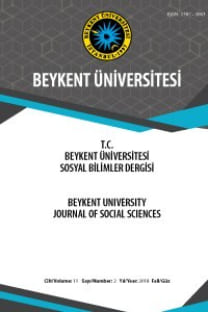İŞ TATMİNİN, ÖRGÜTSEL ADALETİN İŞTEN AYRILMA NİYETİ İLİŞKİSİNDEKİ ARACILIK ROLÜ
Öz
Bu çalışmanın amacı, örgütsel adaletin çalışanların işten ayrılma niyetilerine etkisini ve iş tatmininin bu etkideki aracılık rolünü araştırmaktır. Çalışmaya İstanbul’da bulunan özel ve kamu bankalarından 371 çalışan katılmıştır. Niehoff ve Moorman (1993), Minnesota Memnuniyet Anketi (1967) ve Grandey (1999) tarafından geliştirilmiş ölçeklerden faydalanılarak anket formu hazırlanmış ve veriler toplamıştır. Araştırma sonuçlarına göre, çalışanların hem dağıtımsal hemde etkileşimsel adalet değerlemelerinin artması onların işten ayrılma niyetini azaltmaktadır. Ayrıca, iş tatminin hem dağıtımsal hemde etkileşimsel adaletin işten ayrılma niyeti üzerinde kısmi aracılık etkisi olduğu bulunmuştur.
Anahtar Kelimeler:
Örgütsel Adalet Algısı, İş Tatmin, İşten Ayrılma Niyeti
___
Aghaei, Najaf; Moshiri, Keivan ve Shahnaz Shahrbanian (2012), “Relationship between Organizational Justice and Intention to Leave in Employees of Sport and Youth Head Office of Tehran”, European Journal of Experimental Biology, 2 (5), ss:1564-1570 .Akanbi, Paul Ayobami Ofoegbu, Onyema Eugene (2013), “Impact Of Perceived Organizational Justice On Organizational Commitment Of A Food And Beverage Firm In Nigeria”, International Journal Of Humanities And Social Science, 3(14) , ss.207-2018
Al-Zu’bi, H.A., (2010), “A study of relationship between organizational justice and job satisfaction.” International Journal of Business and Management. 5 (12), pp.102-109.
Arokiasamy, Anantha Raj A. (2013), “A Qualitative Study on Causes and Effects of Employee Turnover in the Private Sector in Malaysia”, Middle-East Journal of Scientific Research 16 (11),ss. 1532-1541.
Aryee, S., P. S. Budhwar ve Z. X. Chen, (2002) “Trust as a Mediator of the Relationship between Organizational Justice and Work Outcomes: Test of a Social Exchange Model”, Journal of Organizational Behavior, 23, ss. 267-285.
Baron, M. R., Kenny, D. A. (1986). “The Moderator-Mediator Variable Distinction in Social Psychological Research: Conceptual, Strategic, and Statistical Considerations,” Journal of Peronality and Social Psychology, 51 (6),ss. 1173–1182.
Chen, Zhen Xiong, Anne S. Tsui ve Jiing-Lih Farh (2002), “Loyalty to Supervisor vs. Organizational Commitment: Relationships to Employee Performance in China”, Journal of Occupational and Organizational Psychology, 75, ss. 339-356.
Choi, S. (2011), “Organizational justice and employee work attitude: The federal case”. The American Review of Public Administration, 41(2), ss.185-204
Cohen-Charash, Yochi and Paul E. Spector; (2001), “The Role of Justice in Organizations: A Meta-Analysis ”, Organizational Behavior and Human Decision Processes, 86(2), ss. 278-321.
Colquitt, Jason A and Greenberg, J. (2003), Organizational Justice: A Fair Assessment of the State of the Literature. In. Organizational Behavior, Ed: J. Greenberg, Second Edition, Lawrence Erlbaum Associates Inc, New Jersey 2003.
Colquitt, Jason A., Donald E., Conlon, Christopher O.L.H. Porter, Michael J Wesson ve Yee K. NG; (2001), “Justice at the Millenium: A Meta Analytic Review of 25 Years of Organizational Justice Research”, Journal of Applied Pschology, 86(3), ss. 425- 445.
Cotton, John L. ve Tuttle, Jeffrey M., 1986, “Employee Turnover: A Meta-Analysis and Review with Implications for Research”, The Academy of Management Review, 11(1), ss:55–70.
Cropanzano, Russell; David E. Bowen, and Stephen W. Gilliland (2007), “The Management of Organizational Justice”, Academy of Management Perspectives,
Crow, Matthew S.; Chang; Bae Lee, Ja-Jin Joo, (2012) "Organizational justice and organizational commitment among South Korean police officers: An investigation of job satisfaction as a mediator", Policing: An International Journal of Police Strategies & Management, Vol. 35 Iss: 2, ss.402 - 423
Çorbacıoğlu, Sıtkı (2013), Çalışanların motive edilmesi ve ödüllendirilmesi, içinde:Yönetimin Esasları, Çev Ed. Adem Öğüt, 8. Baskı, Nobel Yayınevi.
De Simone, S. ; G. Cicotto , J. Lampis (2016) “le stress au travail, la satisfaction au travail et la santé physique chez les enseignants, Revue Européenne de Psychologie Appliquée”/European Review of Applied Psychology, 66(2), 65-77.
Eğilmezkol, G., (2011). Organizational justice and organizational commitment in work life, a study aimed at the analysis of the organizational justice and organizational commitment of the employees in a public bank. Undergraduate dissertation. Ankara: Gazi University.
Elovainio M1, Linna A, Virtanen M, Oksanen T, Kivimäki M, Pentti J, Vahtera J., (2013) “Perceived organizational justice as a predictor of long-term sickness absence due to diagnosed mental disorders: results from the prospective longitudinal Finnish Public Sector Study”, Social Science Medicine;91,ss:39-47
Erkuş, A.,Turunç, Ö., ve Yücel, R., (2011), “Örgütsel adalet ve örgütsel bağlılık arasındaki ilişkilerde içsel ve dışsal iş tatmininin aracılık rolü: Bankacılık sektöründe bir araştırma”. Eskişehir Osmangazi Üniversitesi İktisadi ve İdari Bilimler Fakültesi Dergisi. 6(1) ss.245-270.
Franz, Cheryl; (2004), “A Cross Cultural Study of Employee Empowerment and Organizational Justice”, W ayne State University, Detroit, Michigan, ss. 1-158.
Garavan, T. N., Morley, M., Gunnigle, P., ve Collins, E. (2001), “Human Capital accumulation: The role of human resource development”, Journal of European Industrial Training, 25(2/3/4), ss.48-68.
Görgülüer, Ayça, Aysun (2013) Örgütsel Adalet Ve İş Tatmi̇ninin Örgütsel Bağlılığa Etki̇Si̇ Üzerine bir Arastırma, Niğde Üniversitesi Yükseklisans Tezi
Grandey, A. A. (1999). The Effects of Emotional Labor: Employee Attitudes, Stress and Performance. Undergraduate Dissertation. Colorado State University, Colorado.
Greenberg, J. (1990). “Organizational justice: Yesterday, today and tomorrow” Journal of Management, 16,ss. 399 ,432.
Greenberg, Jerald ve Baron, Robert A. (2000), Behavior in Organizations, Seventh Edition, New Jersey: Prentice Hall.
Hamel, G., Prahalad, C. K. (1994). Competing for the future. Boston: HBS Press.
Hassan, Arif (2002), “Organızatıonal Justıce As A Determınant Of Organızatıonal Commıtment And Intentıon To Leave”, Asian Academy Of Management Journal, Vol. 7, No. 2, 55–66
- ISSN: 1307-5063
- Yayın Aralığı: Yılda 2 Sayı
- Başlangıç: 2007
- Yayıncı: Beykent Üniversitesi
Sayıdaki Diğer Makaleler
INDIVIDUAL ANTECEDENTS of EMOTIONAL LABOUR in AIRLINE INDUSTRY
ULUSLARARASI REKLAMCILIKTA KÜLTÜREL FARKLILIKLAR VE TOPLUMSAL CİNSİYET ROLLERİ
İŞ TATMİNİN, ÖRGÜTSEL ADALETİN İŞTEN AYRILMA NİYETİ İLİŞKİSİNDEKİ ARACILIK ROLÜ
Ebru Beyza BAYARÇELİK, Mukaddes Mine AFACAN FINDIKLI
YENİLİKÇİ SÜREÇ YÖNETİMİNDE YALIN ÜRETİM SİSTEMATİĞİ
Mehmet Şahin GÖK, Tuğkan ARICI
YAKIN DÖNEM TÜRKİYE-FRANSA İLİŞKİLERİ: GELECEĞE DAİR ÖNGÖRÜLER
